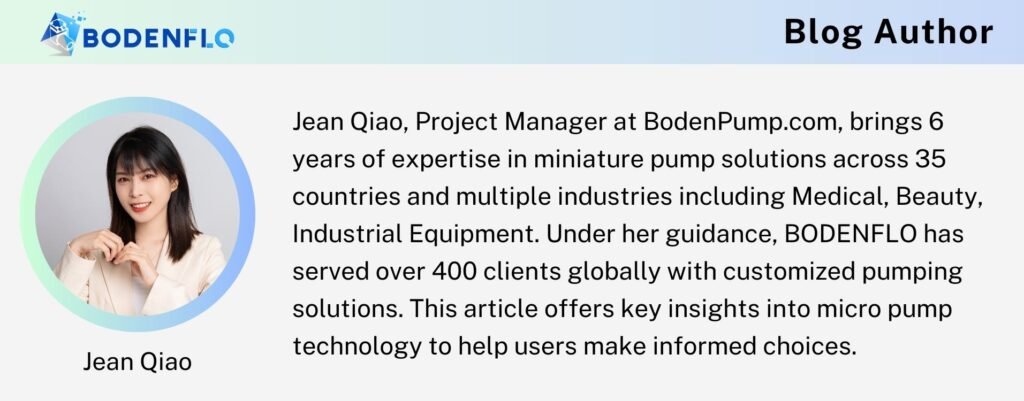
In the world of miniature pumps, one of the most common queries we encounter at BODENFLO is about enhancing the flow rate. As the product manager, I've worked closely with these devices and understand the intricacies involved in optimizing their performance. Increasing the flow rate of a miniature pump isn’t just about turning a dial; it involves a nuanced understanding of pump mechanics and thoughtful modifications.
So, how exactly can you increase the flow rate of a miniature pump? The answer lies in a combination of design adjustments, component upgrades, and operational tweaks. By implementing these changes, you can significantly enhance the pump's efficiency and output.
Let’s explore the various methods to achieve this, ensuring that your miniature pumps operate at their maximum potential.
Understanding the Basics of Flow Rate in Miniature Pumps
What factors fundamentally affect the flow rate in miniature pumps?
- Pump Design and Size: The inherent design and size of the pump are critical in determining its maximum flow rate. This includes the diameter of the pump chamber and the design of the impeller or diaphragm. Larger chambers and specifically designed impellers or diaphragms can facilitate a greater volume of fluid movement, thereby increasing the flow rate. However, these changes must be made while keeping in mind the pump’s overall efficiency and intended application.
- Motor Power: The motor's power is a direct influencer of the pump's ability to move fluid. A more powerful motor usually translates into a higher flow rate, as it can generate more force to push or pull the fluid through the pump. When considering a motor upgrade for increased flow rate, it’s essential to balance the power increase with the pump's design and operational limits to avoid potential damage or inefficiency.
Enhancing Motor Performance for Increased Flow Rate
How can improving motor performance lead to increased flow rate in miniature pumps?
- Motor Upgrades: Replacing the existing motor with a higher-quality or more powerful variant can significantly boost the pump's flow rate. This upgrade should be aligned with the pump’s design to ensure compatibility and prevent overloading.
- Motor Speed Adjustments: In pumps where motor speed can be regulated, optimizing the speed settings can effectively increase the flow rate. This approach requires a careful balance, as excessively high speeds can lead to increased wear and tear or even mechanical failure.
Redesigning Pump Components for Enhanced Flow
What role does the redesign of pump components play in increasing flow rate?
- Impeller or Diaphragm Design: Altering the size, shape, or material of the impeller or diaphragm can significantly impact the flow rate. A design that maximizes efficiency in fluid movement can lead to an increased flow rate.
- Internal Pathway Optimization: Streamlining the internal pathways of the pump to minimize resistance can enhance fluid flow, contributing to a higher overall flow rate. This involves smoothing internal surfaces and reducing obstructions that can impede fluid movement.
Optimizing System Configurations for Improved Flow
How can adjusting the overall system setup enhance the flow rate of miniature pumps?
- Piping System Adjustments: The configuration of the piping system connected to the pump plays a crucial role in its overall performance. Optimizing the layout and diameter of the pipes can significantly affect the flow rate. Straighter pipe runs with fewer bends and larger diameters can reduce resistance and improve flow efficiency. Additionally, ensuring that the piping material is compatible with the pumped fluid and the operating pressure is essential for maintaining a consistent flow rate.
- PWM Speed Control: Pulse Width Modulation (PWM) is an effective method to control the speed of the pump’s motor, thereby adjusting its flow rate. PWM allows for fine-tuning the motor speed with high precision, enabling the pump to operate at the most efficient point for the desired flow rate. This method is particularly useful in applications where the flow rate needs to be varied or controlled in response to changing conditions. Implementing PWM control requires a compatible motor and controller setup, and it offers the advantage of maintaining efficiency at various flow rates, unlike simple voltage adjustments.
Additional Methods to Increase Air Flow in Miniature Pumps
Enhancing the flow rate of miniature pumps can be approached through various advanced methods. While these techniques can effectively increase airflow, it’s important to consider their impact on the pump's overall performance and energy efficiency.
- Modifying Pump Operating Frequency: Adjusting the operational frequency of the pump can alter its flow rate. This involves changing the speed at which the pump’s components move, directly affecting the volume of air moved. However, altering the frequency can impact the pump's efficiency and longevity, as it may operate outside its optimal design parameters. This method requires careful calibration to balance increased flow rate with maintained pump performance.
- Using Control Valves: Installing control valves at the pump's outlet is another way to regulate flow rate. By adjusting the valve’s openness, you can control the outlet pressure and flow rate. While this method offers precise control over the flow, it can lead to increased energy consumption as the pump works against the resistance created by the valve. It's a trade-off between control and efficiency that needs to be considered.
- Incorporating Gearboxes for Speed Variation: The installation of gearboxes on the pump’s drive shaft is a mechanical approach to vary the pump’s speed and consequently its flow rate. This method allows for a range of flow rates by changing the gears, which in turn alters the speed of the pump. However, implementing gearboxes requires high mechanical precision and can add complexity to the pump system.
- Utilizing Frequency Converters for Precise Control: Frequency converters can change the output frequency based on the input power frequency. By adding a frequency converter to the pump’s power supply, you can achieve precise control over the pump’s speed. This method offers fine-tuning of the flow rate, providing flexibility in various applications. However, it also requires compatible electrical systems and can add to the overall cost of the pump setup.
Conclusion
Enhancing the flow rate of miniature pumps is a multifaceted challenge that requires a deep understanding of pump design, motor performance, and operational nuances. At BODENFLO, we specialize in providing solutions that not only increase flow rate but also ensure the longevity and reliability of our pumps. Through careful design, precise engineering, and thoughtful customization, we help our clients achieve the optimal performance necessary for their diverse applications.


